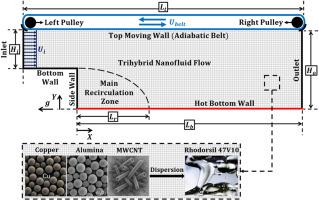Hydrothermal and entropy generation analysis of mixed convection heat transfer in Couette–Poiseuille flow of a trihybrid nanofluid over a backward-facing step
IF 5
2区 工程技术
Q1 ENGINEERING, MECHANICAL
International Journal of Thermal Sciences
Pub Date : 2025-09-06
DOI:10.1016/j.ijthermalsci.2025.110283
引用次数: 0
Abstract
This study introduces and systematically investigates a novel Couette–Poiseuille backward-facing step configuration, in which the conventional stationary upper wall is replaced by a uniformly moving belt. The flow domain is filled with a trihybrid nanofluid composed of () nanoparticles, enabling the interplay of pressure-driven and shear-driven forces within a sudden-expansion geometry with . Numerical analysis explores the effects of varying Reynolds numbers (), Rayleigh numbers (), Grashof numbers (), and top wall terminal velocity ratios () on flow behavior, heat transfer, and entropy generation, with the constant Prandtl number () of . At low , aiding wall motion stabilizes the flow and minimizes entropy generation, while opposing wall motion induces strong recirculation, vortex shedding, and Kelvin–Helmholtz instabilities at higher . Thermal field analysis reveals that counter-flow enhances convective mixing and thermal dispersion, whereas co-flow confines heated fluid near the lower wall. The moving wall improves heat transfer performance by up to in optimal opposing-flow conditions and reduces the Irreversibility-to-Heat Transfer Index () by over at low , where values remain below , indicating high thermodynamic efficiency. However, at high , entropy generation increases by more than times compared to , and rises sharply, peaking at , highlighting the cost of intensified shear and recirculation. Entropy generation analysis, including Bejan number () and , identifies transitions from thermal to frictional irreversibility as increases and wall motion intensifies. The study defines four distinct hydrothermal regimes based on the Cumulative Heat Transfer Enhancement Ratio () and Thermo-Hydraulic Performance Factor (), highlighting trade-offs between enhanced mixing and viscous dissipation. Three thermodynamic regimes, Diffusion-Dominated, Transitional Coupled, and Inertia-Dominated, are characterized by evolving entropy profiles and thermodynamic efficiency. The results offer new insights into optimizing mixed convection flows using wall-driven mechanisms and advanced trihybrid nanofluids for superior heat transfer and energy performance in compact thermal systems.

后向台阶上三杂化纳米流体Couette-Poiseuille流动混合对流换热的热液及熵产分析
本研究介绍并系统地研究了一种新的Couette-Poiseuille后向台阶结构,其中传统的固定上壁被均匀移动的皮带取代。流动区域充满了由(Al2O3 - Cu - MWCNT)纳米颗粒组成的三杂化纳米流体,使压力驱动和剪切驱动的力在ER=2的突然膨胀几何结构中相互作用。数值分析探讨了不同雷诺数(100≤ReH≤500)、瑞利数(6.99×105≤RaH≤1.75×107)、Grashof数(1.0×104≤GrH≤2.5×105)和顶壁末端速度比(- 3≤Ubelt,r≤+3)对流动行为、传热和熵产的影响,Prandtl数(Pr)恒定为69.93。在低ReH条件下,帮助壁面运动稳定流动并使熵产生最小化,而在高ReH条件下,相反的壁面运动引起强烈的再循环、漩涡脱落和开尔文-亥姆霍兹不稳定性。热场分析表明,逆流增强了对流混合和热分散,而共流将受热流体限制在下壁附近。在最佳反流条件下,移动壁面的传热性能提高了14%,在低ReH条件下,不可逆性传热指数(IHTI)降低了90%以上,其值保持在5×10−7以下,表明热力学效率很高。然而,当ReH=500时,与ReH=100相比,熵产增加了10倍以上,IHTI急剧上升,在4.2×10−6处达到峰值,突出了切变和再循环加剧的代价。熵生成分析,包括Bejan数(Be)和IHTI,确定了随着ReH的增加和壁面运动的加剧,从热不可逆性到摩擦不可逆性的转变。该研究基于累积传热增强比(CHTER)和热液性能因子(THPF)定义了四种不同的热液状态,突出了增强混合和粘性耗散之间的权衡。扩散主导、过渡耦合和惯性主导三种热力学状态,其特征是熵分布和热力学效率的不断变化。研究结果为利用壁面驱动机制和先进的三混合纳米流体优化混合对流流动提供了新的见解,从而在紧凑型热系统中实现卓越的传热和能量性能。
本文章由计算机程序翻译,如有差异,请以英文原文为准。
求助全文
约1分钟内获得全文
求助全文
来源期刊

International Journal of Thermal Sciences
工程技术-工程:机械
CiteScore
8.10
自引率
11.10%
发文量
531
审稿时长
55 days
期刊介绍:
The International Journal of Thermal Sciences is a journal devoted to the publication of fundamental studies on the physics of transfer processes in general, with an emphasis on thermal aspects and also applied research on various processes, energy systems and the environment. Articles are published in English and French, and are subject to peer review.
The fundamental subjects considered within the scope of the journal are:
* Heat and relevant mass transfer at all scales (nano, micro and macro) and in all types of material (heterogeneous, composites, biological,...) and fluid flow
* Forced, natural or mixed convection in reactive or non-reactive media
* Single or multi–phase fluid flow with or without phase change
* Near–and far–field radiative heat transfer
* Combined modes of heat transfer in complex systems (for example, plasmas, biological, geological,...)
* Multiscale modelling
The applied research topics include:
* Heat exchangers, heat pipes, cooling processes
* Transport phenomena taking place in industrial processes (chemical, food and agricultural, metallurgical, space and aeronautical, automobile industries)
* Nano–and micro–technology for energy, space, biosystems and devices
* Heat transport analysis in advanced systems
* Impact of energy–related processes on environment, and emerging energy systems
The study of thermophysical properties of materials and fluids, thermal measurement techniques, inverse methods, and the developments of experimental methods are within the scope of the International Journal of Thermal Sciences which also covers the modelling, and numerical methods applied to thermal transfer.
 求助内容:
求助内容: 应助结果提醒方式:
应助结果提醒方式:


